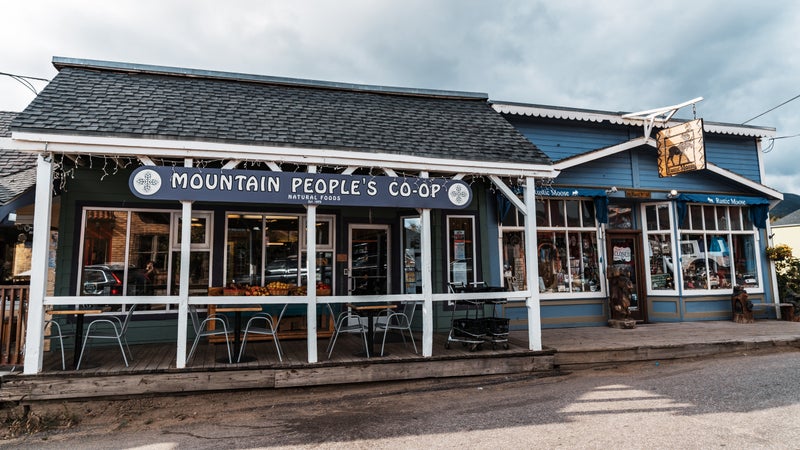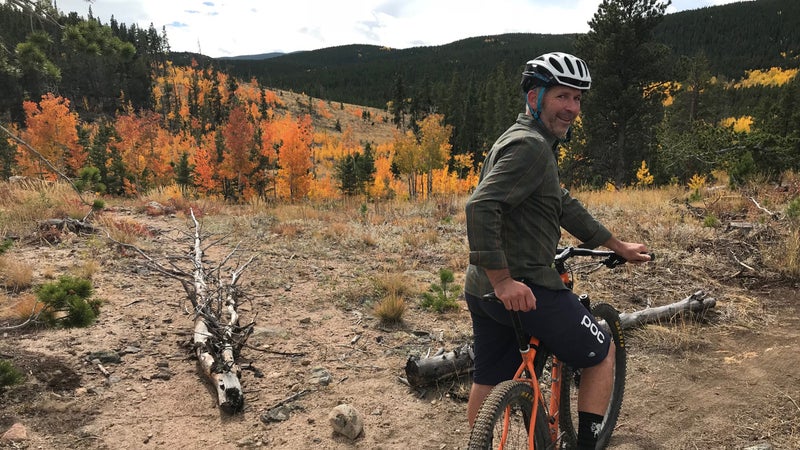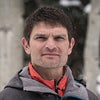The Battle to Ride Mountain Bikes in Nederland, Colorado
Since 2011, a venomous battle has been waged over the two-wheeled soul of Nederland, Colorado (population 1,500). On the one side: locals who ride the trails every day. On the other: people from down canyon in Boulder (population 107,000) who mostly ride them on weekends.
New perk: Easily find new routes and hidden gems, upcoming running events, and more near you. Your weekly Local Running Newsletter has everything you need to lace up! .
Josh HarrodÌıpedals throughÌıhis hometown at a childâs pace, savoring the autumn emptiness and crisp air at 8,200 feet. ItâsÌıearly October in Nederland, a last bastion of Front Range freedom located 13 miles west of Boulder, which might as well be New York City as far as localÌıNedheadsÌılike Harrod are concerned. Theirs is a place where residents go door to door asking if anyone needs firewood, and where locals fought the idea of putting sidewalks on their dirt roads. Thereâs a co-op grocery and funky boutiquesÌıand the only chain is Ace Hardware. About 1,500 people live in the city limits, but the broader population extends five miles in any direction and totals around 7,500. âThe reason I moved up here 20 years ago is because it wasnât Boulder,â Harrod says. âYou could go out and get lost in the woods.â
Harrod, 47, has graying stubble and is wearing a plaid, collared shirt for our mellow weekday jaunt. WeÌımet that morning at , a local shop where he works as a bike and ski tech. Tin Shed also serves asÌıunofficial headquarters of the , an advocacy group that Harrod cofounded. The organization has no paid membership but counts about 200 people on its e-mail listÌıas well as $2,000 in donations in the bankÌıand $1,000 in tools that Harrod, NATOâs president, stores in his garage.
Five minutes into our ride, Harrod turns onto a trail called Sugar Magnolia. Known as Sugar Mag, or High Fructose Mag to locals, the boulder-strewn singletrack used to be a steep, ripping connector from downtown Nederland to West Magnoliaâs broader trail network on the southwest side of town. One day in the spring of 2011, Harrod was riding home from work when he found the trail flagged for a reroute. Two days later, a new trail had been cut adjacent to the original. Some of it had been machine graded into a four-foot-wide path with none of the technical challenge that defined the prior route. Locals soon learned that the work had been completed by, among others,ÌıtheÌıÌı(BMA), an advocacy organization that made its name fighting for trails around its home city.ÌıThis struck them as strange and more than mildly infuriating. WhyÌıwould a group headquartered a half-hour east and 3,000 feet lower be messing with their backyard?
The answer was complicated. Despite the seemingly sudden intrusion,ÌıBMA had been working on trails in West Magnolia since 2004, soon after the U.S. Forest Service published a travel management plan that indicated Sugar Mag crossed private property and was too steep in places. ReroutingÌıSugar MagÌıhad been on the docket for years, but almost nobody in Nederland knew about it, which is where the strife began. The 2011 work served as an appetizer of sorts for a broader undertaking that became known as the , a Forest Serviceâapproved overhaul of the entire network.

Turning Social Trails into Legal Ones
Until recently, the Nederland system included more than 60 miles of singletrack, mostlyÌıtrails that locals had built ad hocÌıover a period of decades. Only about 16 miles wereÌıconsidered legal by the Forest Service, which is where things got sticky. BMA drafted a master plan in 2014 that inventoried all theÌıunofficialÌıtrails,Ìımany of which were subsequently marked for obliteration, including some that locals had been riding for years. BMA claims its goal isÌıto expand the networkâbringing it up to 44 miles of systemÌıtrailsâand generally make it more rideable, smoothing out technical features and wideningÌıcertain sections of singletrack close to town, for example. Nedheads contend that the organization is overstepping its bounds and should focus on its own backyard. But since the trails are all on federalÌıland and part of Boulder County, they fall under BMAâs purview.
The genesis of the conflict can be traced back a decade, when forest transients were Nederlandâs ; they often set up camp in the middle of trails or used the singletrack as their bathroom. There were knife fights, rampant drug use and methamphetamine production andÌıdiscarded needles, unattended campfires, burning diapers, and massive amounts of trash and human waste. Regular law-enforcement patrols helped clean that up, as did a proliferation of bike trails, which brought a lot more people than had ridden there before.
Despite their positive impacts, the increase in singletrack and crowds also created problems. Eventually, it boiled into the rarest kind of mountain-bike-access dispute, wherein two groups of riders (as opposed to, say, cyclists clashing with hikers) battled for control of the same trails. The situation included threats of physical harm and cloak-and-dagger tactics to undermine each otherâs efforts.
âI donât know if people are missing this or justÌıdonât want to see it,â says Corey Keizer, 41, a member of BMA and NATOÌıwho lives in Boulder and is close friends with a lot of riders in Ned. âBut the crux of the issue is that people in Boulder feel like Nederland is theirs. And itâs not.â
âIf I moved to Nederland tomorrow, would my opinion suddenly be more valuable?â counters Jason Vogel, a longtime BMA board member and its former president. âEvery time I hear someone from Nederland say, âThese are our trails, itâs our backyard, so we should have more of a say than you do in what goes on here,â it just rubs me the wrong way.â
Mountain Bikers Want Somewhere to Ride
There probably wouldnât be a problem if Boulder didnât have some of the worst mountain-bike access for a supposed outdoor mecca in America. It was the first U.S. city to , in 1983,Ìıand any local will tell you the allotment of bike-legal trails remains laughably small. BMA was founded in 1991 as the Boulder Offroad Alliance to combat the closure of Boulderâs trails to bikes. It now hasÌımore than 1,000 members, which is still a fraction of the nearly 40,000 mountain bikers around Boulder who wantÌısomewhere to ride.
Despite BMAâs influence as the most powerful fat-tire advocate in the region, it still doesnât trump the established guard in Boulder, which is decidedly hiker first. Time and again through the years, local mountain bikers have encountered a wall of resistance when theyâve tried to expand access anywhere close to their homes.

Nederland, meanwhile, hasÌılong held tight to a ripping trail system accessible from town, primarily in West Magnolia, a.k.a. West Mag. Locals started building singletrack in the late 1980s, andÌıthey added to it in the early and mid-1990s, often duct-taping rakes to their chainstays and dragging trails into shape. Maintenance happened organically; everyone pitched in. But problems arose when word began to trickle downhill.
An hourly bus between Nederland and Boulder served as a pipeline of sorts for new riders to discover the bounty of singletrack around town. It wasnât uncommon for Nederland localsÌıwho worked in Boulder to ride two hours of trail to work then take the bus home, as current Nederland mayor Kris Larsen, a research scientist at the University of Colorado, often does. Harrod did that too for a spellÌıbefore taking a job at Tin Shed when it opened in 2012. âThe trails,â Harrod says, âare the reason this shop happened.â
âThereâs a ruggedness to them, a backcountry feel close to good restaurants and bars,â adds Keizer. âThatâs been intentional.â
But as anyone with a secret stash knows, once the door opens, it can be hard to close. Awareness of the network spread as Boulder grew. ºÚÁϳԹÏÍørs poked around West Mag and got to know its nooks and crannies. This included Vogel, a 40-year-old Austin, Texas, transplant who might be public enemy number oneÌıto Nederland ridersâa distinction he doesnât exactly run from. âThe only reason why BMA knows about social trailsÌıis because I like to explore in the woods, and I happen to be BMAâs main advocacy guy,â Vogel told me the first time we spoke.
Vogel, whoâs been riding West Mag for more than a decade and built the kiosk at the trailhead, also started a bike patrol to crack down on the transients who were shouting at cyclists. He believes that Ned localsâ claims are outdated and driven by NIMBYism. âThe West Mag area is discovered. Like, these arenât your hidden trails anymore,â he says. âThey havenât been hidden since the Forest Service did their first travel-management plan in 2003. That put them on the map.ÌıLatitude 40 had them on their map, all the map companies have these trails on their maps.â
Longtime local John Colton, who has been riding Nederlandâs trails since the mid-eighties, has heard that stance before. âPlease look at it from our point of view,â he says. âThere wasnât a problem.ÌıYou coming up and building a system is creating a problem for us.âÌı
Locals Are Not Happy
The Magnolia Non-Motorized Trails Project overcame numerous hurdles on its way to approval. They included a massive 2013 flood and 2014 wildfire, to say nothing of the social dynamics simmering under the surface.
One might think that a forest in distress would coalesce two groups of like-minded recreationists. Instead, with few exceptions, BMA and NATO got along like battering rams. Thereâs a saying in access disputes: if youâre not at the table, youâre on the menu. And as Nederland residents continued to find trails that had been flagged for reroutes without their input, they wondered what was going on behind the scenes. So in 2013, they filed a Freedom of Information Act request with the Forest Service and learned that then BMA president Vogel had been sending condescending e-mails about NATO to the grand overseerâBoulderâs district ranger, Sylvia Clark. In one, Vogel wrote: âWill NATO be an effective partner in managing the forest? Once Iâve had a chance to feel them out, I will report back and let you know how I personally see the situation evolving.â He asked Clark to keep their exchanges confidential, but the FOIA request resulted in NATO seeing everything heâd written.
âI didnât mean it to be some underhanded maneuver to discredit them,â Vogel says now, âbut I can totally see how they would be like, That asshole was talking behind our backs the whole time.â
AsÌıanyone with a secret stash knows, once the door opens, it can be hard to close.
A furious Nederland local sent a threatening Facebook message to BMAâs executive director at the time, Steve Watts. âYou fucking losers stay away from the Nederland woods and trails or you are going to have some bigger problems on your back.â Watts reported it to the police. The local apologized two hours later for his âidle threat.â
Still, the bad blood festered. A garage band in Ned wrote a song called âTrail Vultures,â in reference to BMA. Tin Shed installed a large map outside its entry showing âtrails to be obliteratedâ and refuting BMAâs claim that it is helping to build a new 44-mile network.
The Forest Service is stuck playing referee, but the agency doesnât seem to mind. âWe think projects like this benefit from having different opinions,â Boulder Ranger District spokesperson Reid Armstrong says.
Implementation of the Magnolia projectÌıbegan in the summer of 2017. That SeptemberÌıa beloved ribbon of singletrack called Aspen Alley and replaced with a much wider, more basicÌıtrail. Harrod calls that loss âthe biggest blow.â Ironically, BMA had included footage of people charging down the old Aspen Alley in a fundraising videoâwhich ultimately helped to pay for the trailâs destruction.
NATO members believe BMAâs machine-built trails are incompatible with the areaâs rugged character. âPeople come to Nederland because itâs different,â Harrod says. âThis has made stuff far easier.â BMA leaders point out that the trails closest to trailheads are designed to be more attainableÌıand that many of the âmore desirableâ trails in West Mag wonât be completed for a decade.
âLook, we need to be able to take people up to the forest, because we have such capacity issues in Boulder. And we need for them to not get in over their heads,â says BMA PresidentÌıMarcus Popetz. âIn a perfect world, if there was a trail that could be built three minutes away from Boulder, yeah, Iâd do that, because then I wouldnât have to drive my car. But since thereâs not, your emotional attachment to these trails doesnât trump the fact that I have tens of thousands of mountain bikers who would like to use a resource that they own.â
Keeping the Secret Trails Secret
We reach the top of High Fructose Mag, and Harrod turns onto Supervü, a newly built, NATO-named trail with a stunning panorama. We snake down the new Aspen Alleyâmuch wider than the original, with whoop-de-do jumpsâand make our way over to Hobbit Two and Three, where BMAâs machines are working to expand and smooth the trail. Harrod harrumphs and decides to turn around before encountering any workers. âI see West Mag as our sacrifice area,â he sighs, adding that he doesnât tell anyone about his secret trails now.
So far only five miles of trail has been eliminated, with the same amount added or rebuilt. But everyone knows more is coming. People are dealing with that in different ways.
âOn one side, Iâm trying to tell my guys in Ned, Change is going to happen, so you can sit here and put a stake in the ground andÌıtry to fight it for as long as you can, but eventually that stake is going to come up and get moved,â CoreyÌıKeizer, BMA and NATO member,Ìısays. âOr you can be the force that steers that change.â
Not everyone in Nederland is against BMA. Mayor Larsen, 43, who was born and raised in Boulder, believes itÌıis âdoing really good workâ and that denying the inevitability of change is ânot realisticâ due to the Front Rangeâs growth.
âYour emotional attachment to these trails doesnât trump the fact that I have tens of thousands of mountain bikers who would like to use a resource that they own.â
Despite their disagreement over whether an opinion should count more if someone lives three or 30 minutes away, leaders of BMA and NATOÌımeet and discuss plans now, a prospect that wouldâve been laughable two years ago. âItâs not great,â Popetz says, âbut we do meet.â
âShared leadership is the wave of the future, as far as designing and implementing projects like this across our public lands,â says the Forest Serviceâs Armstrong. âThatâs not how we handled these projects historically. We would just make decisions.â
Harrod and I continue to Hobbit One, then Re-Root, a popular legacy trail near West Magnolia Road. For all that has happened since he stumbled upon the Sugar Mag pin flags eight years ago, Harrod seems to have found a balance, albeit uncomfortable, between begrudging and accepting the changes.
That doesnât mean he forgives the principle, however. We hop onto a newly built section that he calls Bathroom ViewÌıonly half-jokingly. The trail initially was routed within 10 yards of a local residence, allowing riders a clear sight line into the house as they pedaled past. The owner begged the Forest Service and BMA to move it farther away, which they did. ButÌıHarrod still wonders why it was placed so close to a local’s home toÌıbegin with, given the less intrusive options nearby. He shakes his head.
âJust because you can,â he says, âdoesnât mean you should.â


